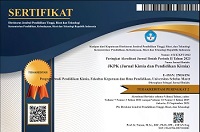Effect of Phosphoric Acid (H3PO4) Activation on the Preparation of Activated Carbon from Gymnostoma Rumphianum Wood
Abstract
Keywords
Full Text:
PDFReferences
[1] C. R. Schwintzer and J. D. Tjepkema, The Biology of Frankia and Actinorhizal Plants, California: Academic Press Inc, 1990.
[2] W. D. Atmanto, W. W. Winarni, B. Primardiyatni, and S. Danarto, "Pertumbuhan Cabang Kayu Cemara pada Jarak Tanam yang Berbeda," Life Science, vol. 8, no. 2, pp. 126–137, 2019.
[3] J. S. Berame, "Preliminary Results of Gymnosperm Species Inventory in Caraga Region XIII, Philippines," International Scientific Indexing, vol. 4, pp. 520–533, 2020.
[4] I. F. Hanum and L. J. G. Van Der Maesen, Plant Resources of South-East Asia 11: Auxiliary plants, Jakarta: LIPI Press, 2007.
[5] K. Sa’diyah, P. H. Suharti, N. Hendrawati, F. A. Pratamasari, and O. M. Rahayu, "Pemanfaatan serbuk gergaji kayu sebagai karbon aktif melalui proses pirolisis dan aktivasi kimia," CHEESA: Chemical Engineering Research Articles, vol. 4, no. 2, pp. 91–99, 2021. doi: https://doi.org/10.25273/cheesa.v4i2.8589.91-99
[6] A. Prasetiyo, R. D. Ratnani, and I. Riwayati, "Pemanfaatan limbah batang pisang (Musa paradisiaca L.) sebagai sumber karbon aktif teraktivasi dengan penerapan metode pirolisis dan asam fosfat (H3PO4)," Prosiding Sains Nasional dan Teknologi, vol. 14, no. 1, pp. 198–208, 2024.
[7] N. F. Azzahra and D. Tanggasari, "Sifat Mutu Arang Aktif Kayu Bidara (Ziziphus mauritiana) Dengan Penambahan larutan H3PO4 Berdasarkan Variasi Suhu Aktivasi," Jurnal Biosistem Protech, vol. 4, no. 1, pp. 36–44, 2024. doi: https://doii.org/10.36761/fagi.v4i2.3583
[8] S. Jamilatun, E. N. Putri, Z. Arifah, and I. Mufandi, "The Effect of Single and Double Activation with Potassium Hydroxide 2N on Charcoal from Fir Wood (Casuarina Junghuhniana) Pyrolysis," CHEMICA: Jurnal Teknik Kimia, vol. 7, no. 1, pp. 11–18, 2020. doi: https://doi.org/10.26555/chemica.v7i1.15651
[9] A. Saban, Jasruddin, and Husain, "Pengaruh Konsentrasi Aktivator (NaOH dan HCl) Terhadap Karakteristik Karbon Aktif Dari Tongkol Jagung," Jurnal Sains dan Pendidikan Fisika (JSPF), vol. 19, no. 2, pp. 219–228, 2023.
[10] M. Shellyanti and N. Komari, "Pembuatan dan Karakterisasi Arang Aktif dari Kayu Alaban (Vitex Pinnata L.) Menggunakan Asam Asetat," Jurnal Natural Scientiae, vol. 3, no. 2, pp. 33–37, 2023. doi: https://doi.org/10.20527/jns.v3i2.9892
[11] I. Alouiz et al., "Elaboration of fibrous structured activated carbon from olive pomace via chemical activation and low-temperature pyrolysis," Heliyon, vol. 10, no. 20, pp. 1–13, 2024. doi: https://doi.org/10.1016/j.heliyon.2024.e38886
[12] A. M. S. Ngueabouo et al., "Strategy for optimizing the synthesis and characterization of activated carbons obtained by chemical activation of coffee husk," Materials Advances, vol. 3, no. 22, pp. 8361–8374, 2022.
[13] P. Feng, J. Li, H. Wang, and Z. Xu, "Biomass-based activated carbon and activators: preparation of activated carbon from corncob by chemical activation with biomass pyrolysis liquids," ACS Omega, vol. 5, no. 37, pp. 24064–24072, 2020. doi: https://doi.org/10.1021/acsomega.0c03494
[14] M. N. Islam et al., "Preparation and characterization of activated carbon from jute stick by chemical activation: comparison of different activating agents," Saudi Journal of Engineering and Technology, vol. 7, no. 2, pp. 112–117, 2022. doi: https://doi.org/10.36348/sjet.2022.v07i02.008
[15] L. S. Daniel et al., "The production of activated carbon from Acacia erioloba seedpods via phosphoric acid activation method," Bioresource Technology Reports, vol. 23, 2023. doi: https://doi.org/10.1016/j.biteb.2023.101568
[16] H. Hasanah, R. Sirait, and R. Y. Lubis, "Pengaruh Konsentrasi Aktivator H3PO4 Terhadap Karbon Aktif Ampas Tebu," Journal Online of Physics, vol. 8, no. 1, pp. 11–15, 2022.
[17] D. Youlanda, S. Sitorus, and B. Yusuf, "Pemanfaatan arang aktif serbuk gergaji kayu bangkirai (Shorea Lavefolia Endert)," Jurnal Atomik, vol. 7, no. 1, pp. 18–21, 2022.
[18] D. S. Rini et al., "Effect of activation temperature and H3PO4 concentration on activated carbon from Asian Palmyra Palm Fronds," Jurnal Multidisiplin Madani, vol. 4, no. 6, pp. 720–728, 2024.
[19] Y. Yuliawati and L. H. Rizaldi, "Sifat Mutu Arang Aktif Kayu Bidara (Ziziphus mauritiana) Dengan Larutan Kimia Natrium Hidroksida," Food and Agro-industry Journal, vol. 4, no. 2, pp. 1–10, 2023. doi: https://doi/org/10.36761/fagi.v4i2.3583
[20] J. P. G. Sutapa et al., "Utilization of sapwood waste of fast-growing teak in activated carbon production," Journal of the Korean Wood Science and Technology, vol. 52, no. 2, pp. 118–133, 2024. doi: https://doi.org/10.5658/WOOD.2024.52.2.118
[21] H. Megherbi et al., "The effect of phosphoric acid on the properties of activated carbons from Myrtus communis leaves," J. Mol. Struct., vol. 1321, no. 3, p. 140038, 2024. doi: https://doi.org/10.1016/j.molstruc.2024.140038
[22] S. Saitun, U. Pato, and Y. Zalfiatri, "Konsentrasi Asam Fosfat (H3PO4) Terhadap Karakteristik Arang Aktif Dari Tempurung Buah Nipah," Sagu Journal: Agricultural Science and Technology, vol. 23, no. 1, pp. 16–22, 2024.
[23] Y. Indrayani et al., "Influence of activated charcoal addition on the properties of particleboard," Jurnal Sylva Lestari, vol. 10, no. 3, pp. 294–309, 2022. doi: https://doi.org/10.23960/jsl.v10i3.560
[24] C. Bijang et al., "Synthesis and characterization of activated carbon from waste compedak fruit," Jurnal Akademika Kimia, vol. 11, no. 1, pp. 56–63, 2022.
[25] A. Fitriansyah, H. Amir, and E. Elvinawati, "Karakterisasi adsorben karbon aktif dari sabut pinang," Alotrop, vol. 5, no. 1, pp. 42–54, 2021.
[26] H. Haritha et al., "Production and characterization of activated charcoal from cocoa pod," M.S. thesis, KCAET Tavanur, Kerala Agricultural Univ., India, 2023.
[27] P. H. Setyarini, F. Cendikia, and A. A. A. Sonief, "Enhance the quality of medical liquid waste," International Journal of Integrated Engineering, vol. 16, no. 2, pp. 144–152, 2024.
[28] T. F. Adawi, I. M. L. Aji, and D. S. Rini, "Pengaruh Suhu dan Konsentrasi Asam Fosfat terhadap Arang Aktif Bambu Duri," Jurnal Penelitian Kehutanan Faloak, vol. 5, no. 1, pp. 62–73, 2021. doi: https://doi.org/10.20886/jpkf.2021.5.1.62-73
[29] R. Dwityaningsih et al., "Pengaruh variasi konsentrasi H3PO4 terhadap karakteristik karbon aktif dari sekam padi," Infotekmesin, vol. 14, no. 1, pp. 98–104, 2023. doi: https://doi.org/10.35970/infotekmesin.v14i1.1641
[30] V. A. Tiwow et al., "Pola Inframerah Arang Tempurung Kelapa Hasil Pemurnian," Chem Prog., vol. 14, no. 2, pp. 116–123, 2021. doi: https://doi.org/10.35799/cp.14.2.2021.37191
[31] L. S. Wijaya, D. S. Afuza, and E. Kurniati, "Arang Aktif Serbuk Kayu Jati Menggunakan Aktivator H3PO4 dan Modifikasi TiO2," Jurnal Teknik Kimia, vol. 16, no. 2, pp. 73–79. doi: https://doi.org/10.33005/jurnal_tekkim.v16i2.3048
[32] M. S. Hanavia, C. I. A. Meliati, and L. Rubianto, "Pengaruh Suhu Pirolisis dan Konsentrasi Aktivator NaCl," DISTILAT: Jurnal Teknologi Separasi, vol. 8, no. 1, pp. 202–212, 2022. doi: https://doi.org/10.33795/distilat.v8i1.325
[33] A. Budianto et al., "Physics and chemical activation to produce activated carbon from palm oil bunch waste," IOP Conf. Ser.: Mater. Sci. Eng., vol. 10, pp. 1–8, 2021. doi: https://doi.org/10.1088/1757-899X/1010/1/012016
[34] K. N. Argianti, Y. Simbolon, E. B. Panggabean, Khairahmi, and M. K. Fahrozi, "Pengaruh Aktivasi Asam Dan Basa Terhadap Karakter Biochar Sebagai Katalis Heterogen," Jurnal Matematika dan Ilmu Pengetahuan Alam, vol. 5, no. 2, pp. 1–7, 2024.
[35] M. S. Hossen, T. Islam, S. M. Hoque, A. Islam, M. M. Bashar, and G. Bhat, "Synthesis, activation, and characterization of carbon fiber precursor derived from jute fiber," ACS Omega, vol. 9, no. 33, pp. 35384–35393, 2024. doi: https://doi.org/10.1021/acsomega.4c01268
[36] A. E. Nemr, R. M. Aboughaly, A. El Sikaily, S. Ragab, M. S. Masoud, and M. S. Ramadan, "Utilization of sugarcane bagasse/ZnCl2 for sustainable production of microporous nano-activated carbons of type I for toxic Cr (VI) removal from aqueous environment," Biomass Conversion and Biorefinery, vol. 13, no. 3, pp. 1581–1600, 2023.
[37] C. A. Riyanto, M. S. Ampri, and Y. Martono, "Synthesis and characterization of nano activated carbon from Annatto Peels (Bixa orellana L.) viewed from temperature activation and impregnation ratio of H3PO4," EKSAKTA: Journal of Sciences and Data Analysis, vol. 1, pp. 44–50, 2020. doi: https://doi.org/10.20885/EKSAKTA.vol1.iss1.art7
Refbacks
- There are currently no refbacks.








